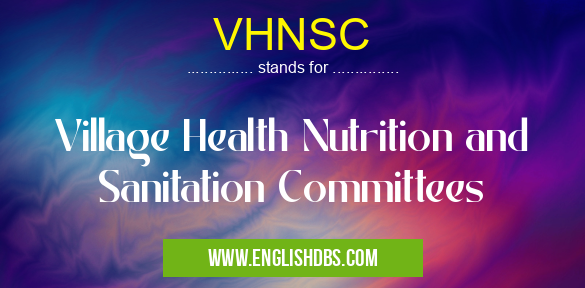What does VHNSC mean in HEALTHCARE
Village Health Nutrition and Sanitation Committees (VHNSC) are an important part of the health policy landscape in India. It is a group of people, usually local villagers appointed by the government, who work together to ensure that their village has a healthy environment, nutritious food and adequate sanitation facilities. The VHNSC is charged with monitoring the availability of safe drinking water, proper disposal of solid waste and managing other important public health services like immunization campaigns. Through its efforts, it seeks to create awareness among residents about the importance of maintaining good hygiene practices and nutrition for overall well-being.

VHNSC meaning in Healthcare in Medical
VHNSC mostly used in an acronym Healthcare in Category Medical that means Village Health Nutrition and Sanitation Committees
Shorthand: VHNSC,
Full Form: Village Health Nutrition and Sanitation Committees
For more information of "Village Health Nutrition and Sanitation Committees", see the section below.
» Medical » Healthcare
What does VHNSC Do?
The duties and responsibilities of the Village Health Nutrition and Sanitation Committee are varied. Primarily, its members are responsible for advocating improved health habits among village residents through education and outreach activities on topics such as hand washing and basic nutrition. Its members also take part in village-level programs that prevent ailments such as malaria or dengue fever from spreading throughout an affected community. Additionally, they work closely with national health officials to ensure that essential healthcare services like immunizations and vaccinations reach rural villages which may otherwise be unserved due to lack of resources or access.
Essential Questions and Answers on Village Health Nutrition and Sanitation Committees in "MEDICAL»HEALTHCARE"
What is a Village Health Nutrition and Sanitation Committee (VHNSC)?
Village Health Nutrition and Sanitation Committees (VHNSC) are groups of volunteers, typically from the local community, dedicated to improving health and nutrition in rural areas. This can include providing nutritional education and advice as well as sanitation initiatives for clean water and sanitation facilities.
How does a VHNSC make an impact?
VHNSCs provide access to important resources that help reduce malnutrition and improve the overall health of the population in rural areas. They focus on nutrition, hygiene, disease prevention, sanitation promotion, and sometimes even healthcare provision. Ultimately it leads to better health outcomes for people living in rural areas.
What are the objectives of a VHNSC?
The main objective of a VHNSC is to reduce chronic malnutrition among children aged 6 months to 2 years old. Other objectives include promoting good hygiene practices, increasing access to safe drinking water, reducing infectious diseases through vaccinations and providing basic healthcare services such as diagnosis and treatment of common illnesses.
Who can be part of the VHNSC?
Members of the VHNSC may be appointed by local governments or selected by local communities themselves. Selection criteria vary between organisations; however they usually require individuals with interests related to health or nutrition like activists or medical professionals.
What activities do members of a VHNSC undertake?
Common activities undertaken by members of a VHNSC include raising awareness about nutrition-related issues within their community; monitoring childhood malnutrition levels; providing nutrition counselling services for pregnant women, lactating mothers and children; providing training on food security topics such as how to safely store food; promoting sanitation initiatives for clean water sources; running campaigns about disease prevention through immunization; linking community members with primary healthcare services; collecting data about local health issues; organizing meetings with government representatives about health related matters etc.
Where can I find more information about a VHNSC?
You can find more information about the Village Health Nutrition and Sanitation Committee (VHNSC) online or at your local government office. You can also contact your nearest NGO working in rural development who would have more information on setting up a committee in your community area.
How long does it take to set up a VHNCS?
The time it takes to set up a Village Health Nutrition & Sanitation Committee will depend on factors such as availability of volunteers, funding support and resources required for implementation etc., however generally it should take around one month or so if everything goes smoothly from start till finish.
How often do village health committees meet?
The frequency at which village health committees meet depends on the specific needs of each particular group and its context - some may meet weekly while others might meet monthly or sporadically depending on need/demand.
Are there any potential risks associated with being part of a village health committee?
All volunteering has associated risk however these are generalised risks which could apply when undertaking any kind of volunteer activity including but not limited too personal safety risks such as being exposed to unsanitary conditions if travelling alone into remote villages or physical labour relating to construction etc.
Final Words:
In summary, Village Health Nutrition and Sanitation Committees are a vital part of India's comprehensive health policy framework. Working at a grassroots level in rural areas across the country, they strive to promote better living conditions through effective education programs while ensuring that critical medical care is made available to all citizens regardless of their socio-economic standing. By fulfilling these responsibilities, VHNSCs promote healthier lifestyles in communities where a healthy lifestyle often seems out of reach due to poverty or geographical barriers.
VHNSC also stands for: |
|
| All stands for VHNSC |
